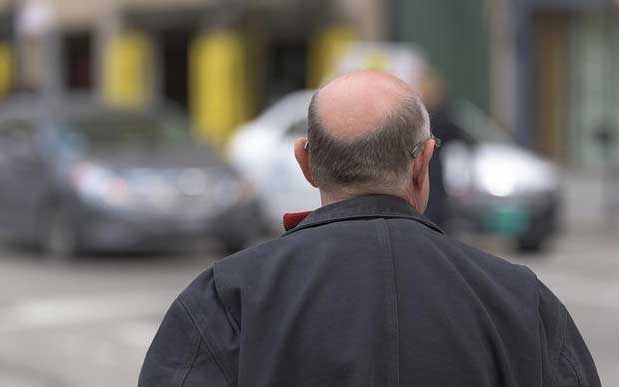
Breakthrough drug restores more than 90% of lost hair in most patients
The cure for baldness may be already here ? for some people at least.
Columbia University Medical Center (CUMC) researchers published the results of a promising pilot trial in the Journal of Clinical Investigation/Insight this September. Twelve patients with moderate to severe baldness caused by alopecia areata (AA), an autoimmune disorder where the person?s own cells attack their hair follicles, were given the JAK inhibitor ruxolitinib. As with earlier animal and small human studies, the drug proved to be almost miraculous in its hair-raising powers in whih 75 percent of patients gained more than 90 percent of their lost hair back during the 3 to 6 months of treatment with the drug.
?Although our study was small, it provides crucial evidence that JAK inhibitors may constitute the first effective treatment for people with alopecia areata,? said the study′s lead author Dr. Julian Mackay-Wiggan, an associate professor and director of the clinical research unit in dermatology at CUMC as well as a dermatologist at New York-Presbyterian/Columbia, in a statement. ?This is encouraging news for patients who are coping with the physical and emotional effects of this disfiguring autoimmune disease.?
Encouraging as the results are, there are several substantial caveats to make clear. For one, the ?cure? was often temporary. Once people went off the drug, a third began to lose hair again, though not to the same degree as before. In a related study of another JAK inhibitor, tofacitinib, also published in theJournal of Clinical Investigation/Insight this month, was less successful both during and after the trial. Out of 66 subjects with various degrees of AA, including some who lost all hair along their bodies, 32 percent experienced 50 percent or greater improvement from the disease during treatment. But after 8.5 weeks off the drug, everyone had begun to lose some hair.
?Our findings suggest that initial treatment induces a high rate of disease remissions in patients with moderate to severe alopecia areata but maintenance therapy may be needed,? Mackay-Wiggan said.
And while both drugs were tolerated safely by patients with no severe side-effects, they did come with some milder ones. Namely, they weakened the immune system and made people more likely to become sick.
Unfortunately, the biggest sticking point to these treatments is that they may not do anything for the majority of hair loss sufferers. As mentioned earlier, AA, like rheumatoid arthritis, is an autoimmune disorder, which means the mechanism that causes baldness happens in these people is different than what causes the most common kind of baldness ? androgenic alopecia, or male and female pattern baldness. Despite the risk of hair loss post treatment, it would certainly be a great boon to the approximately four million people in America currently suffering from AA.
Along with finding ways to identify early on who will or won?t respond to the treatment, Mackay-Wiggan and her colleagues do plan to test out JAX inhibitors against androgenic alopecia as well as other hair loss conditions in the near future.
We expect JAK inhibitors to have widespread utility across many forms of hair loss based on their mechanism of action in both the hair follicle and immune cells,? said co-author Dr .Angela M. Christiano, a professor of genetics and development and dermatology at Columbia.
A relatively new class of drugs, JAK inhibitors have already been approved to treat bone marrow cancers and rheumatoid arthritis. Time will tell if they may also someday lead to the end of hair loss.
Related News

How to Lose Weight Fast: 3 Simple Steps, Based on Science

Losing Weight in Hot Weather Made Easy

Top 10 Unknown Beauty Tips and Tricks

Learn How To Do Pearl Facial At Home To Get Naturally Glowing Skin Instantly

Dairy and vitamin D supplements protect against bone loss

23 foods that contain NO calories

10 Natural beauty tips for face you must try

5 Hot Yoga Poses For Rapid Weight Loss
Most Read
★9 Simple Yoga Asanas & Tips for Weight Loss
★10 Ways To Use Sesame Oil For Beautiful Skin
★6 Fantastic Yoga Asanas That Will Help You Fight Skin Problems
★Weight-lifting and protein shakes rich in growth hormones may make you bald
★10 Weight Loss Tips to Make Things Easier (and Faster)
★Cancer risk of breast implants 10 times higher than first feared
★Daily consumption of tea protects the elderly from cognitive decline
★23 foods that contain NO calories
★10 Most Effective Weight Loss Exercises For Torching Fat
★Growing Propagating and Using Aloe Vera
★The best effective and natural plants for a good memory
★Yoga Heals More than Just Your Body
★How you should wash your face?
★Why You Need to Start Combining Avocados and Peaches
★5 Exercises to Reduce Belly Fat
★Face Open Pores
★How to prevent peanut allergies in children?
★Dandelion Benefits Biodiversity, Soil and Your Health
★Fresh fruits and veggies arent always healthier than frozen, scientists say
★Mans lips exploded after he became 'addicted' to fillers
★Cancer warning over skin bleaching treatment
★This is how many calories your tea and coffee habit is adding to your diet EVERY DAY
★5 Dairy-Free Cheese Options Worth Trying
★Top 3 Core Exercises While Pregnant
★Ideal exercises to keep your heart healthy
★Acne sufferers likely to live longer than people with flawless skin
★Study reveals alarming dangers of anti-ageing jabs
★Skin tone linked to fruit and vegetable consumption
★7 Must-Eat Fermented Foods for a Healthy Gut
★Fasting might be good for your healh, research says
★Flex Your Memory Muscle
★How to Do Face Cleansing at Home?
★Everyday Medications You Should Never Take When You Exercise
★Study finds dramatic weight loss can be achieved WITHOUT counting calories
★Medication Management Tips
★A platter full of seafood
★Pasta eaters may have better diet quality: study
★Eating Carbs and Fats Before a Workout? Read This
★Natural Herbal Gummies
★6 Foods You Can Incorporate In Your Fat Burner Diet For Best Results
★4 Totally avoidable gym mistakes
★How to Make Elderberry Syrup
★Hard work, no pay linked to mental health issues in comedians
★Outdoor Activities to Lose Weight
★Aerobic training can help reverse ageing
★15 Kitchen Herbs and Spices with Powerful Health Benefits
★Is there a way to combat greying?
★Why most people use emotional words to persuade others
★Smoking and sight loss warning
★5 Hot Yoga Poses For Rapid Weight Loss
